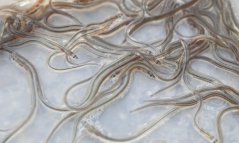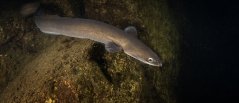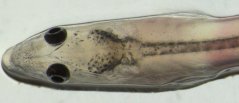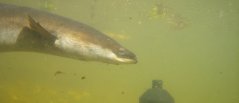
Longread
“We actually want to get inside the head of the eel”
The eel is a fascinating and mysterious but also endangered fish. Researchers are trying to learn more about the eel's spectacular migration. Their journey covering thousands of kilometres between freshwater and salt water has now become an obstacle course of dams, dykes and locks.
The reproductive cycle of the European eel (Anguilla anguilla) can be described as an incredible journey. Nearly adult eels – called ‘silver eels’ - swim from Europe's rivers, lakes, pools and ditches to the sea. They cross the Atlantic Ocean to spawn some 6,000 kilometres away, in the Sargasso Sea. After spawning, they probably die quickly. Larvae hatch from the eggs and come to Europe on ocean currents, growing into glass eels during their journey. When they arrive at the coast, they are about seven centimetres long. They migrate into freshwater, where they grow up to become silver eels. Sometime between the ages of 10 and 30, they seek the ocean again to provide their own offspring.

“It’s a really bizarre idea that an eel larva would cross the entire ocean on its way to freshwater,” says Ben Griffioen, a research associate at Wageningen Marine Research, a research institute of Wageningen University & Research. “There are more species of fish that migrate between fresh and salt water, but the distances travelled by the eel are truly remarkable.”
It’s a really bizarre idea that an eel larva would cross the entire ocean on its way to freshwater
Other eel species do the same. “American eels also spawn in the Sargasso Sea, but their larvae take a different turn,” says Reindert Nijland, associate professor of Molecular Marine Ecology at Wageningen University & Research. “They choose the sea current to North America. The Japanese eel, which is found in large parts of Asia, also spawns in salt water, but in their case it’s the Pacific Ocean.”
Griffioen and Nijland are members of the Wageningen University & Research's Eel Project Group, in which 30 researchers from a wide range of disciplines in a variety of studies are trying to unlock the secrets of the eel. Because there's a lot about the eel that we don't know yet.
Accumulations of eels
For example: what triggers the fish to embark on its spectacular migration? “It’s probably to do with drainage: if there’s a lot of rain, it’s very energy-efficient to swim towards the sea with that runoff,” says Nijland. “For that reason, migration usually peaks in autumn. But we are now seeing some year-round migration taking place.” The exact location where the eels spawn? Unknown. No one has ever found eel eggs or spawning eels in the ocean. How they find their way, exactly which route they take - is unknown.
Nor do we know very much about what the larvae eat on their long journey to the European coast. “Presumably all kinds of micro-organisms and zooplankton. Initially, the larvae don’t even have a useful mouth. Their teeth interlock like a cage. Perhaps they absorb food through the skin. Their diet also changes during the journey.” Finally, we don't really understand the evolutionary utility of this unusual reproductive method. “That’s something we can speculate a lot about. Either way, it must have been a successful strategy; otherwise, the eel would have disappeared long ago.”

Yet that is exactly what is in danger of happening. Because however successful the reproductive strategy was in the past, today the eel is facing serious obstacles. Literally: Europe's rivers have been turned into obstacle courses with countless locks, dams, dykes, hydropower plants, pumping stations, complicating both the departure of silver eels and the immigration of glass eels.
What happens if eels can’t get past such obstacles? “The urge to migrate is so strong that eels are unlikely to discontinue it,” Griffioen says. “We use acoustic cameras and transmitters to study how silver eels behave near a barrier and to what extent they manage to reach the sea. If they try to swim through pumping stations, they are at great risk. If there is no way out at all, silver eels can sometimes be trapped in inland waters for years.”
The urge to migrate is so strong that eels are unlikely to discontinue it
Glass eels are too small to be fitted with a transmitter. Groups of glass eels are therefore manually colour-tagged so that they can be tracked. “We do this to calculate how many glass eels arrive or how long they are held up somewhere. Sometimes you get accumulations of hundreds of thousands to millions of glass eels along the coast. If they can’t find an entrance, we don’t know exactly what happens to them. Presumably, they then face food shortages or increased predation pressure. Some glass eels will then be forced to choose to grow up in salt water, while others will swim further along the coast. This might mean going from Katwijk towards IJmuiden or the Afsluitdijk in search of alternative routes.”
Individual characters
Barriers in waterways are not the only problem facing the eels. The fishing industry (legal and illegal), ship propellers, water pollution, unnatural water flows in highly regulated areas that confuse them during migration - all these factors have caused the eel stock to crash. The arrival of glass eels is only a fraction of what it once was. Consequently, the species is listed as 'critically endangered' on the IUCN Red List.

Through the research projects of the Eel Project Group, Wageningen University & Research wants to help protect the eel and contribute to the recovery of the population. There are plenty of research questions. For example, how do eels navigate through fish passages in dams and locks? Griffioen: “There is a tendency to just tick the box and think everything is fine once a fish passage has been installed somewhere. But we don’t yet know whether they really help. Silver eels follow the main flow of water because that’s quickest, so they often don’t come near fish passages.”
There are eels that ‘recklessly’ try to get past a pumping station, while others are more wary
The character of an individual eel also appears to play a role in how they deal with barriers. “There are eels that ‘recklessly’ try to get past a pumping station, while others are more wary. They let themselves drift along on the current, with their tails forward, so they can quickly swim in the other direction when in danger. Others are even more cautious and turn around at a great distance. Through our studies, we are trying to understand their behaviour as well as possible. We actually want to get inside the head of the eel. That will enable us to recommend measures to make those barriers more eel-friendly.”
All those obstacles in the water can also result in unintended selection of eels. Nijland: “Instead of natural selection, you get a kind of artificial selection, based on behaviour, stress tolerance or size, for example. Larger females are more vulnerable than smaller male silver eels when passing turbines. That selection pressure is another thing we don’t know much about.”
AI cameras
Meanwhile, a national barrier map for glass eels has been produced. “We already had maps for the silver eel, but now there is also a list of bottlenecks and junctions that are important for the glass eel,” says Griffioen. Research is also being conducted on the senses of eels to discover how they navigate and how they respond to water flows with scents or fresh-salt gradients in the water. Sensing boxes packed with cameras, sensors and hydrophones are also being installed to map the migration of the eels. “We use a whole range of tags, sensors and transmitters to track the eel. Recently also with AI video cameras that can recognise and record all kinds of fish species passing by.”

Another innovation is the deployment of eDNA sensors, which can measure in the water the presence of eel DNA in skin cells and faeces left behind, for example. Nijland: “We expect that we will soon also be able to distinguish between silver eels and glass eels via eDNA. Through so-called DNA methylation we will then also be able to establish the age and sex of the eels from eDNA. This is all crucial information to get a clear picture of the population status and reproductive capacity.”
With the results of the studies, government agencies and public bodies can take management measures to come to the aid of the eel. Griffioen works at Wageningen Marine Research for clients like Rijkswaterstaat and the Ministry of Agriculture, Fisheries, Food Security and Nature. At Wageningen University, Nijland is involved in several academic research programmes to close knowledge gaps regarding eels. Because the eel is literally a transboundary fish, it can only be protected through international cooperation. The Wageningen Eel Project Group therefore cooperates at European level within the ICES Working Group on Eels and globally through the interdisciplinary research network COST Action EEL SUPPORT.
An eel only has to die once somewhere in the cycle and you’ve lost it
“If you want to protect the eel, you need a holistic view,” Griffioen explains. “It's not enough if the eel is doing slightly better in the Netherlands when that’s not the case in the rest of Europe. Or if you only do something to improve the entry of glass eels, without considering the hinterland. The silver eels must also be able to leave it later; otherwise, you would inadvertently create an ecological sink.” Nijland: “An eel only has to die once somewhere in the cycle and you’ve lost it. It is precisely this unique reproductive cycle of the eel that makes research so challenging - and fascinating.”